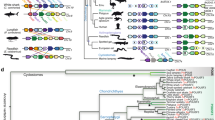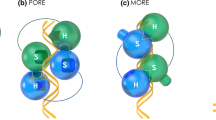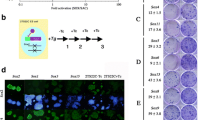Abstract
The origin and evolution of molecular mechanisms underlying cellular pluripotency is a fundamental question in stem cell biology. The transcription factor Oct4 or Pou5f1 identified in mouse features pluripotency expression and activity in the inner cell mass and embryonic stem (ES) cells. Pou2 identified in zebrafish is the non-mammalian homolog prototype of mouse Oct4. The genes oct4 and pou2 have reportedly evolved by pou5 gene duplication in the common ancestor of vertebrates. Unlike mouse oct4, however, zebrafish pou2 lacks pluripotency expression and activity. Whether the presence of pluripotency expression and activity is specific for mammalian Oct4 or common to the ancestor of vertebrate Oct4 and Pou2 proteins has remained to be determined. Here we report that Oloct4, the medaka oct4/pou2, is essential for early embryogenesis and pluripotency maintenance. Oloct4 exists as a single copy gene and is orthologous to pou2 by sequence and chromosome synteny. Oloct4 expression occurs in early embryos, germ stem cells and ES cells like mouse oct4 but also in the brain and tail bud like zebrafish pou2. Importantly, OlOct4 depletion caused blastula lethality or blockage. We show that Oloct4 depletion abolishes ES cell derivation from midblastula embryos. Thus, Oloct4 has pluripotency expression and is essential for early embryogenesis and pluripotency maintenance. Our results demonstrate the conservation of pluripotency expression and activity in vertebrate Oct4 and Pou2 proteins. The finding that Oloct4 combines the features of mouse oct4 and zebrafish pou2 in expression and function suggests that Oloct4 might represent the ancestral prototype of vertebrate oct4 and pou2 genes.







Similar content being viewed by others
Abbreviations
- Dpc or hpc:
-
Day (s) or hour (s) post culture
- Dpf or hpf:
-
Day (s) or hour (s) post fertilization
- ES:
-
Embryonic stem
- FISH:
-
Fluorescence in situ hybridization
- IF:
-
Immunofluorescence
- MBE:
-
Midblastula embryo
References
Scholer, H. R., Balling, R., Hatzopoulos, A. K., Suzuki, N., & Gruss, P. (1989). Octamer binding proteins confer transcriptional activity in early mouse embryogenesis. The EMBO Journal, 8, 2551–7.
Scholer, H. R., Ruppert, S., Suzuki, N., Chowdhury, K., & Gruss, P. (1990). New type of POU domain in germ line-specific protein Oct-4. Nature, 344, 435–9.
Okamoto, K., Okazawa, H., Okuda, A., Sakai, M., Muramatsu, M., & Hamada, H. (1990). A novel octamer binding transcription factor is differentially expressed in mouse embryonic cells. Cell, 60, 461–72.
Niwa, H., Miyazaki, J., & Smith, A. G. (2000). Quantitative expression of Oct-3/4 defines differentiation, dedifferentiation or self-renewal of ES cells. Nature Genetics, 24, 372–6.
Nichols, J., Zevnik, B., Anastassiadis, K., Niwa, H., Klewe-Nebenius, D., Chambers, I., Scholer, H., & Smith, A. (1998). Formation of pluripotent stem cells in the mammalian embryo depends on the POU transcription factor Oct4. Cell, 95, 379–91.
Kehler, J., Tolkunova, E., Koschorz, B., Pesce, M., Gentile, L., Boiani, M., Lomeli, H., Nagy, A., McLaughlin, K. J., Scholer, H. R., & Tomilin, A. (2004). Oct4 is required for primordial germ cell survival. EMBO Reports, 5, 1078–83.
Takahashi, K., & Yamanaka, S. (2006). Induction of pluripotent stem cells from mouse embryonic and adult fibroblast cultures by defined factors. Cell, 126, 663–76.
Takeda, H., Matsuzaki, T., Oki, T., Miyagawa, T., & Amanuma, H. (1994). A novel POU domain gene, zebrafish pou2: expression and roles of two alternatively spliced twin products in early development. Genes and Development, 8, 45–59.
Frankenberg, S., & Renfree, M. B. (2013). On the origin of POU5F1. BMC Biology, 11, 56.
Niwa, H., Sekita, Y., Tsend-Ayush, E., & Grutzner, F. (2008). Platypus Pou5f1 reveals the first steps in the evolution of trophectoderm differentiation and pluripotency in mammals. Evolution and Development, 10, 671–82.
Frankenberg, S., Pask, A., & Renfree, M. B. (2010). The evolution of class V POU domain transcription factors in vertebrates and their characterisation in a marsupial. Developmental Biology, 337, 162–70.
Onichtchouk, D. (2012). Pou5f1/oct4 in pluripotency control: insights from zebrafish. Genesis, 50, 75–85.
Tapia, N., Reinhardt, P., Duemmler, A., Wu, G., Arauzo-Bravo, M. J., Esch, D., Greber, B., Cojocaru, V., Rascon, C. A., Tazaki, A., Kump, K., Voss, R., Tanaka, E. M., & Scholer, H. R. (2012). Reprogramming to pluripotency is an ancient trait of vertebrate Oct4 and Pou2 proteins. Nature Communications, 3, 1279.
Boiani, M., & Scholer, H. R. (2005). Regulatory networks in embryo-derived pluripotent stem cells. Nature Reviews. Molecular Cell Biology, 6, 872–84.
Reim, G., & Brand, M. (2002). Spiel-ohne-grenzen/pou2 mediates regional competence to respond to Fgf8 during zebrafish early neural development. Development, 129, 917–33.
Lachnit, M., Kur, E., & Driever, W. (2008). Alterations of the cytoskeleton in all three embryonic lineages contribute to the epiboly defect of Pou5f1/Oct4 deficient MZspg zebrafish embryos. Developmental Biology, 315, 1–17.
Reim, G., & Brand, M. (2006). Maternal control of vertebrate dorsoventral axis formation and epiboly by the POU domain protein Spg/Pou2/Oct4. Development, 133, 2757–70.
Lunde, K., Belting, H. G., & Driever, W. (2004). Zebrafish pou5f1/pou2, homolog of mammalian Oct4, functions in the endoderm specification cascade. Current Biology, 14, 48–55.
Hong, Y., & Schartl, M. (1996). Establishment and growth responses of early medakafish (Oryzias latipes) embryonic cells in feeder layer-free cultures. Molecular Marine Biology and Biotechnology, 5, 93–104.
Hong, Y., Winkler, C., & Schartl, M. (1998). Production of medakafish chimeras from a stable embryonic stem cell line. Proceedings of the National Academy of Sciences of the United States of America, 95, 3679–84.
Hong, Y., Liu, T., Zhao, H., Xu, H., Wang, W., Liu, R., Chen, T., Deng, J., & Gui, J. (2004). Establishment of a normal medakafish spermatogonial cell line capable of sperm production in vitro. Proceedings of the National Academy of Sciences of the United States of America, 101, 8011–6.
Yi, M., Hong, N., & Hong, Y. (2009). Generation of medaka fish haploid embryonic stem cells. Science, 326, 430–3.
Li Z, M Li, N Hong, M Yi and Y Hong. (2014). Formation and cultivation of medaka primordial germ cells. Cell Tissue Res
Sanchez-Sanchez, A. V., Camp, E., Garcia-Espana, A., Leal-Tassias, A., & Mullor, J. L. (2010). Medaka Oct4 is expressed during early embryo development, and in primordial germ cells and adult gonads. Developmental Dynamics, 239, 672–9.
Froschauer, A., Khatun, M. M., Sprott, D., Franz, A., Rieger, C., Pfennig, F., & Gutzeit, H. O. (2013). oct4-EGFP reporter gene expression marks the stem cells in embryonic development and in adult gonads of transgenic medaka. Molecular Reproduction and Development, 80, 48–58.
Hong, Y., Winkler, C., & Schartl, M. (1996). Pluripotency and differentiation of embryonic stem cell lines from the medakafish (Oryzias latipes). Mechanisms of Development, 60, 33–44.
Hong N, S Chen, R Ge, J Song, M Yi and Y Hong. (2012). Interordinal Chimera Formation Between Medaka and Zebrafish for Analyzing Stem Cell Differentiation. Stem Cells Dev
Hong, N., Li, M., Zeng, Z., Yi, M., Deng, J., Gui, J., Winkler, C., Schartl, M., & Hong, Y. (2010). Accessibility of host cell lineages to medaka stem cells depends on genetic background and irradiation of recipient embryos. Cellular and Molecular Life Sciences, 67, 1189–1202.
Iwamatsu, T. (2004). Stages of normal development in the medaka Oryzias latipes. Mechanisms of Development, 121, 605–18.
Xu, H., Gui, J., & Hong, Y. (2005). Differential expression of vasa RNA and protein during spermatogenesis and oogenesis in the gibel carp (Carassius auratus gibelio), a bisexually and gynogenetically reproducing vertebrate. Developmental Dynamics, 233, 872–82.
Yan, Y., Hong, N., Chen, T., Li, M., Wang, T., Guan, G., Qiao, Y., Chen, S., Schartl, M., Li, C. M., & Hong, Y. (2013). p53 gene targeting by homologous recombination in fish ES cells. PLoS ONE, 8, e59400.
Li, M., Hong, N., Xu, H., Yi, M., Li, C., Gui, J., & Hong, Y. (2009). Medaka vasa is required for migration but not survival of primordial germ cells. Mechanisms of Development, 126, 366–81.
Xu, H., Li, Z., Li, M., Wang, L., & Hong, Y. (2009). Boule is present in fish and bisexually expressed in adult and embryonic germ cells of medaka. PLoS ONE, 4, e6097.
Xu, H., Li, M., Gui, J., & Hong, Y. (2007). Cloning and expression of medaka dazl during embryogenesis and gametogenesis. Gene Expression Patterns, 7, 332–8.
Zhao, H., Hong, N., Lu, W., Zeng, H., Song, J., & Hong, Y. (2012). Fusion gene vectors allowing for simultaneous drug selection, cell Labeling, and reporter assay in vitro and in vivo. Anal: Chem.
Hong, Y., Chen, S., Gui, J., & Schartl, M. (2004). Retention of the developmental pluripotency in medaka embryonic stem cells after gene transfer and long-term drug selection for gene targeting in fish. Transgenic Research, 13, 41–50.
Li, M., Hong, N., Gui, J., & Hong, Y. (2012). Medaka piwi is Essential for Primordial Germ Cell Migration. Current Molecular Medicine, 12, 1040–9.
Hong, Y., & Schartl, M. (1996). Establishment and growth responses of early medaka (Oryzias latipes) embryonic cells in feeder layer-free culture. Molecular Marine Biology and Biotechnology, 5, 93–104.
Yuan, Y., Li, M., Hong, N., & Hong, Y. (2014). Correlative light and electron microscopic analyses of mitochondrial distribution in blastomeres of early fish embryos. The FASEB Journal, 28, 577–85.
Amores, A., Force, A., Yan, Y. L., Joly, L., Amemiya, C., Fritz, A., Ho, R. K., Langeland, J., Prince, V., Wang, Y. L., Westerfield, M., Ekker, M., & Postlethwait, J. H. (1998). Zebrafish hox clusters and vertebrate genome evolution. Science, 282, 1711–4.
Lippok, B., Song, S., & Driever, W. (2014). Pou5f1 protein expression and posttranslational modification during early zebrafish development. Developmental Dynamics, 243, 468–77.
Li, M., Shen, Q., Wong, F. M., Xu, H., Hong, N., Zeng, L., Liu, L., Wei, Q., & Hong, Y. (2011). Germ cell sex prior to meiosis in the rainbow trout. Protein & Cell, 2, 48–54.
Li, M., Shen, Q., Xu, H., Wong, F. M., Cui, J., Li, Z., Hong, N., Wang, L., Zhao, H., Ma, B., & Hong, Y. (2011). Differential conservation and divergence of fertility genes boule and dazl in the rainbow trout. PLoS ONE, 6, e15910.
Millane, R. C., Kanska, J., Duffy, D. J., Seoighe, C., Cunningham, S., Plickert, G., & Frank, U. (2011). Induced stem cell neoplasia in a cnidarian by ectopic expression of a POU domain transcription factor. Development, 138, 2429–39.
Wang, D., Manali, D., Wang, T., Bhat, N., Hong, N., Li, Z., Wang, L., Yan, Y., Liu, R., & Hong, Y. (2011). Identification of pluripotency genes in the fish medaka. International Journal of Biological Sciences, 7, 440–51.
Mohapatra, C., Patra, S. K., Panda, R. P., Mohanta, R., Saha, A., Saha, J. N., Mahapatra, K. D., Jayasankar, P., & Barman, H. K. (2014). Gene structure and identification of minimal promoter of Pou2 expressed in spermatogonial cells of rohu carp. Mol Biol Rep: Labeo rohita.
Ye, H., Du, H., Chen, X. H., Cao, H., Liu, T., & Li, C. J. (2012). Identification of a pou2 ortholog in Chinese sturgeon, Acipenser sinensis and its expression patterns in tissues, immature individuals and during embryogenesis. Fish Physiology and Biochemistry, 38, 929–42.
Rodda, D. J., Chew, J. L., Lim, L. H., Loh, Y. H., Wang, B., Ng, H. H., & Robson, P. (2005). Transcriptional regulation of nanog by OCT4 and SOX2. The Journal of Biological Chemistry, 280, 24731–7.
Chew, J. L., Loh, Y. H., Zhang, W., Chen, X., Tam, W. L., Yeap, L. S., Li, P., Ang, Y. S., Lim, B., Robson, P., & Ng, H. H. (2005). Reciprocal transcriptional regulation of Pou5f1 and Sox2 via the Oct4/Sox2 complex in embryonic stem cells. Molecular and Cellular Biology, 25, 6031–46.
Loh, Y. H., Wu, Q., Chew, J. L., Vega, V. B., Zhang, W., Chen, X., Bourque, G., George, J., Leong, B., Liu, J., Wong, K. Y., Sung, K. W., Lee, C. W., Zhao, X. D., Chiu, K. P., Lipovich, L., Kuznetsov, V. A., Robson, P., Stanton, L. W., Wei, C. L., Ruan, Y., Lim, B., & Ng, H. H. (2006). The Oct4 and Nanog transcription network regulates pluripotency in mouse embryonic stem cells. Nature Genetics, 38, 431–40.
Yeo, J. C., & Ng, H. H. (2013). The transcriptional regulation of pluripotency. Cell Research, 23, 20–32.
Li, M., Zhu, F., & Hong, Y. (2013). Differential evolution of duplicated medakafish mitf genes. International Journal of Biological Sciences, 9, 496–508.
Hong N, M Schartl and Y Hong. (2014). Derivation of stable zebrafish ES-like cells in feeder-free culture. Cell Tissue Res.
Acknowledgments
We thank J. Deng for fish breeding, Choy Mei Foong and Veronica Wong for laboratory management. This work was supported by the National Research Foundation Singapore (NRF-CRP7-2010-03).
Author Disclosure Statement
No competing financial interests exist.
Author information
Authors and Affiliations
Corresponding author
Electronic supplementary material
Below is the link to the electronic supplementary material.
Fig. S1
Cloning and sequence of Oloct4. (A) Cloning strategy and steps. arrowheads, positions and directions of primers. (B) Sequence. Start codon and stop codon are shown in bold. Primer sequences are underlined with arrows depicting their directions. Amino acid sequences for degenerate primers Pou5 and Pou3 are framed. POUs, POU-specific domain; POUh, POU homeodomain. Primers PR53 and Psb were used for RT-PCR, while PR51 and Psb define the sequence of DNA and RNA probes used in Southern and in situ hybridization. (TIFF 1260 kb)
Fig.S2
Amino acid sequence alignment. Two POU subdomains and the linker between them are defined by arrowheads. The antigenic sequence within the linker used for the production of a polyclonal antibody (αOct4) is underlined. At the end of the alignment are species common names, percentage identity values for full length sequences (full) and partial sequences spanning POU domains (POU). Accession numbers are AY639946.1 for Ol (Oryzias latipes, medaka), NP_571187.1 for Dr (Danio rerio, zebrafish), NP_001081342.1 for Xl (Xenopus laevis), AAT09163.1 for Am (Ambystoma mexicanum, axolotl), ABK27428.1 for Gg (Gallus gallus, chicken), NP_038661 for Mm (Mus musculus, mouse) and CAA77951 for Hs (Homo sapiens, human). (TIFF 940 kb)
Rights and permissions
About this article
Cite this article
Liu, R., Li, M., Li, Z. et al. Medaka Oct4 is Essential for Pluripotency in Blastula Formation and ES Cell Derivation. Stem Cell Rev and Rep 11, 11–23 (2015). https://doi.org/10.1007/s12015-014-9523-2
Published:
Issue Date:
DOI: https://doi.org/10.1007/s12015-014-9523-2




